Twenty-two-year-old University of Colorado Boulder student Jack Murphy was killed in a lightning strike while on a backpacking expedition in Bridger-Teton National Forest on August 2. He was with a group of fourteen adults on a course with the National Outdoor Leadership Schools (NOLS), a nonprofit organization that specializes in wilderness education. Another participant on the trip was also injured but in stable condition.
According to Teton County Search and Rescue (TCSAR), CPR had been in progress for over an hour by the time their helicopter arrived, but Jack could not be revived. According to their analysis, the fatality was a random event and the group had followed best safety practices during the lightning storm, spreading their shelters apart in an area of low-lying terrain amongst trees of even heights. The victim was inside his tent at the time of the strike.
According to KC Bess of TCSAR, the two students struck by lightning were 25 yards apart and may have been affected by a shock that traveled through the ground, also known as a ground current. The other student was reported to have burns and “nerve issues” that can be common after a lightning strike.
Lightning can strike people in multiple ways:
- Direct Strike: lightning extends from the sky directly down to a person, usually in an open area
- Side Flash/Side Splash: lightning first strikes a taller object nearby, then jumps to the victim, often when a person is near a tall tree or other object
- Ground Current: lightning strikes an object and travels along the ground via conductive materials (ie, rainwater) and spreads to a larger area, affecting everything touching the ground (commonly seen in mass livestock deaths)
- Conduction: lightning strikes a conductive object or surface (ie, metal, water) that a person is in contact with at the time of the strike, thereby absorbing the current of the strike
- Streamers: lightning strikes a nearby object and the charge spreads to a person in a nearby area with positively charged ions which carry the charge of the strike
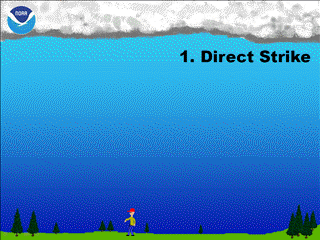
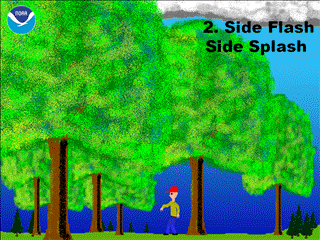
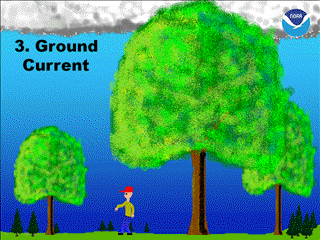
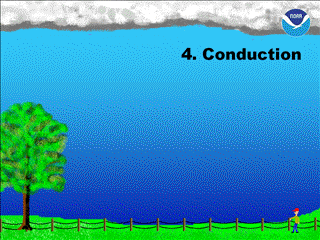
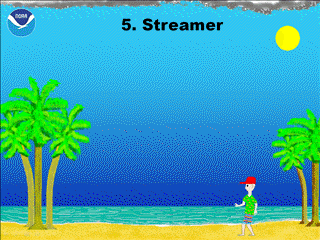
Types of Lightning Strikes. Source: https://www.weather.gov/safety/lightning-struck
Lightning Position/Crouch:
Of note, the lightning position has not been proven to lower the risk of a lightning strike and the National Weather Service stopped recommending it in 2008. However, it is still valuable to review the theory behind the position in situations where definitive shelter is not an option. The lightning position is where your feet are close together (to minimize the distance a ground current would travel) on nonconductive material (to decrease the likelihood that a ground current will enter you) and you are crouched low to avoid the chance of side splash or streamers.

Lightning Position. Source: NOLS.edu
Reverse Triage:
If your group is unlucky enough to be struck by lightning and there are multiple victims, the role of reverse triage applies; the victims that appear to be dead (and would typically be given a black tag) should be attended to first because the chance of getting return of spontaneous circulation (ROSC) is high within the first few minutes of a lightning-induced cardiac arrest. If available, an AED can be used to detect shockable arrhythmias.
Common Lightning Injuries:
- Keraunoparalysis: transient paralysis secondary to vascular spasm from autonomic overstimulation. Presents as a cold and mottled limb with neurologic and pulse deficit. Often resolves within a few hours. Spinal precautions should be maintained until definitive diagnosis can be made.
- Lichtenberg Figure: transient red marks on the skin from suspected damage to superficial blood vessels from lightning being conducted on the surface of moist skin, usually appear one hour after a strike and disappear within 24-48 hours.
- Tympanic Membrane Rupture: rupture of the eardrum from damage to small vessels of the tympanic membrane as they conduct electricity.
- Exploding Clothes: lightning can superheat the moisture on the skin causing it to rapidly vaporize and cause a steam explosion that can blow off clothing.
- Burns: any conductive items (watches, jewelry, belts) can cause contact burns and should be managed as thermal burns.
Prevention:
It is always a good idea to educate yourself about lightning when going outdoors in areas that are prone to thunderstorms and have a plan for taking shelter if you are caught in a storm. According to the WMS Practice Guidelines for the Prevention and Treatment of Lightning Injuries, buildings or vehicles provide the greatest shelter from lightning. If unable to seek definitive shelter, remove any metal objects (Grade 1C), assume the lightning position (2C) and spread your group out by >20ft (1C). Avoid peaks and ridgelines (1C) and exit the water (1C).